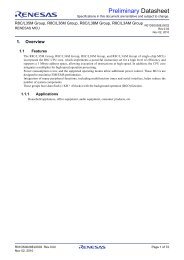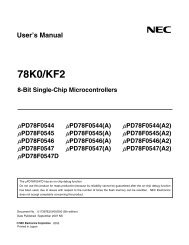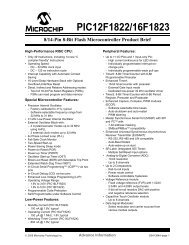xmega a3u - Elfa
xmega a3u - Elfa
xmega a3u - Elfa
Create successful ePaper yourself
Turn your PDF publications into a flip-book with our unique Google optimized e-Paper software.
XMEGA A3U<br />
30. AC – Analog Comparator<br />
30.1 Features<br />
30.2 Overview<br />
• Four Analog Comparators (AC)<br />
• Selectable propagation delay versus current consumption<br />
• Selectable hysteresis<br />
–No<br />
–Small<br />
–Large<br />
• Analog comparator output available on pin<br />
• Flexible input selection<br />
– All pins on the port<br />
– Output from the DAC<br />
– Bandgap reference voltage<br />
– A 64-level programmable voltage scaler of the internal V CC voltage<br />
• Interrupt and event generation on:<br />
– Rising edge<br />
– Falling edge<br />
–Toggle<br />
• Window function interrupt and event generation on:<br />
– Signal above window<br />
– Signal inside window<br />
– Signal below window<br />
• Constant current source with configurable output pin selection<br />
The analog comparator (AC) compares the voltage levels on two inputs and gives a digital output<br />
based on this comparison. The analog comparator may be configured to generate interrupt<br />
requests and/or events upon several different combinations of input change.<br />
Two important properties of the analog comparator’s dynamic behavior are: hysteresis and propagation<br />
delay. Both of these parameters may be adjusted in order to achieve the optimal<br />
operation for each application.<br />
The input selection includes analog port pins, several internal signals, and a 64-level programmable<br />
voltage scaler. The analog comparator output state can also be output on a pin for use by<br />
external devices.<br />
A constant current source can be enabled and output on a selectable pin. This can be used to<br />
replace, for example, external resistors used to charge capacitors in capacitive touch sensing<br />
applications.<br />
The analog comparators are always grouped in pairs on each port. These are called analog<br />
comparator 0 (AC0) and analog comparator 1 (AC1). They have identical behavior, but separate<br />
control registers. Used as pair, they can be set in window mode to compare a signal to a voltage<br />
range instead of a voltage level.<br />
PORTA and PORTB each has one AC pair. Notations are ACA and ACB, respectively.<br />
8386B–AVR–12/11<br />
54

















